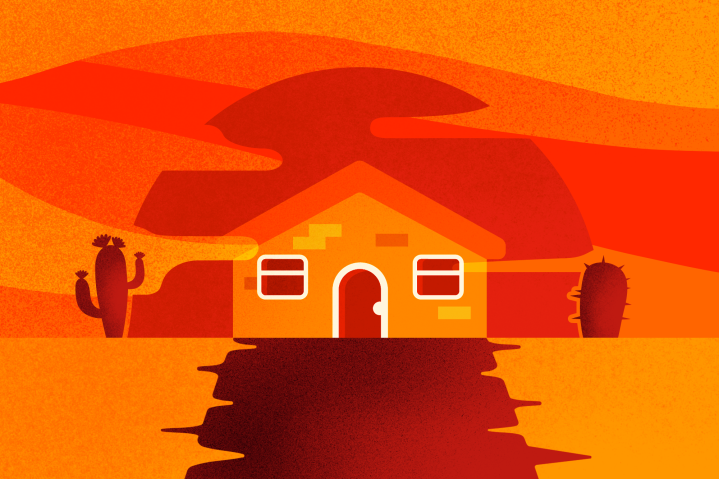
With the mercury set to soar to unprecedented levels in 2020, climate experts fear that record-high temperatures will make lingering coronavirus restrictions far more challenging.
Scientists are increasingly concerned that the combination of global warming, a deepening economic crisis, and pandemic lockdowns could make for a long and sweltering season.
Utility companies turning off power due to lack of payment during the hottest months could even turn into a major public health threat, and cooling centers may not suffice if restrictions prevent too many people from congregating inside.
Johanna Bozuwa, co-manager of the Climate and Energy Program at the Democracy Collaborative, a think tank and research center, said “many are dealing with the realities of unemployment,” and some may find it hard to pay their rising electrical bills.
State governments across the country have instituted bans on utility companies shutting off service due to unpaid bills during the coronavirus pandemic.
But with 21 electricity shutoff bans expiring in June, two-thirds of states could be left without such temporary consumer protections, according to an analysis by the Center for Biological Diversity.
High, high heat
The National Oceanic and Atmospheric Administration (NOAA) has already said there is a 75 percent chance that this year will be the hottest since measurements were first logged in 1880.
Projections show hotter-than-average temperatures from June through August for much of the Northeast and mid-Atlantic, in addition to a large swath of the United States stretching from Texas to the Northwest.
That prediction follows a January-to-March period that ranked as the second-warmest ever, according to NOAA.
“The world’s five hottest years on record have occurred since 2015, as the effects of climate change begin to hit us,” Bozuwa told Digital Trends. “And it looks as if 2020 will be no different.”

Just before the official beginning of meteorological summer, a heat wave in late May engulfed Central California and parts of the Desert Southwest.
Hazardous temperatures well into triple digits blanketed places like Fresno, California, and Phoenix, and skyrocketing night-time temperatures meant less time to cool down before daybreak.
Since average temperatures on land and at sea are determined by long-term trends in greenhouse gas emissions, scientists do not think the global drop in carbon dioxide emissions due to coronavirus shutdowns will move the needle much.
The global drop in carbon dioxide emissions due to coronavirus shutdowns will move the needle much.
Initial studies suggest the coronavirus is weakened by warmer temperatures, but it’s unclear how much the strong sun, heat, and humidity of North American summer will help slow transmission of the virus.
Public health officials in the United States have warned that lockdowns may remain in place during the summer months.
‘More unpaid energy bills’
Older Americans and other vulnerable communities are already disproportionately affected by the coronavirus crisis. More severe medical problems, along with economic woes, could compound the usual summer stressors.
Adrienne Hollis, the Senior Climate Justice and Health Scientist at the Union of Concerned Scientists, said minority and low-income groups — in addition to many rural communities — are among the demographics most sensitive to environmental threats.

“The very people who are becoming sick and dying during the pandemic are the same ones who are most negatively affected by climate change,” Hollis said.
She said that exposure to extreme temperatures can lead to “adverse health effects [and] forced migration to safer areas.”
Hollis also expects “more asthma cases, more heart attacks, more mental health issues, and more unpaid energy bills.”
Air conditioning and other cooling mechanisms could fall short in 2020, with many jobless people unable to afford the basics to prevent bodily overheating.
“The very people who are becoming sick and dying during the pandemic are the same ones who are most negatively affected by climate change.”
“The current cooling areas — of which there were not nearly enough — are most likely not conducive” to obeying safety measures instituted to stop the spread of coronavirus, said Hollis.
She added that governments at all levels face a policy dilemma in keeping people at home and away from beaches and pools. With children not at camp or school, tensions could boil over.
A coalition of 830 social justice groups called for a federal moratorium on utility shutoffs, which Bozuwa said is “imperative to securing the physical and economic health of families across the United States.” But so far no legislation has been passed.
A vulnerable power grid?
For everyday consumers, elevated temperatures will drive up the demand for residential power and could combine with changes in load structure to expose the grid’s flaws to oppressive heat waves.
Susan Tierney, a senior adviser at the Analysis Group consulting firm, said an April report by the North American Electric Reliability Corporation (NERC) showed supply chain disruptions could make the grid more vulnerable in the coming months.

Despite such worries, NERC’s summer reliability assessment says that “projected resources are at or above the levels needed to satisfy summer peak demand under anticipated weather in nearly all assessment areas.”
However, a NERC media advisory issued on May 28 acknowledged that the “unprecedented coronavirus pandemic has led to heightened uncertainty in demand projections” ahead of the peak operating season.
The advisory also said that COVID-19 directly “threatens the health and safety of critical industry workforce.”
Just as cuts by utility provider Con Edison in New York City last summer hit some low-income neighborhoods with high risks of heat-related deaths, Texas or other states with searing temperatures could experience similar issues.
Lower reserve capacity
Some analysts say the electrical grid is ready to handle such an unprecedented summer.
Michael Goggin, vice president of power sector consulting firm Grid Strategies LLC, said accurately forecasting electricity demand is difficult without being able to predict the course of the coronavirus.
On the one hand, he estimates that power demand thus far has been down between 5 and 15 percent, depending on the region of the country. That reduction is driven primarily by less commercial and industrial use.
But with residential sector consumption ticking higher, summer demand will largely be dictated by how quickly the country reopens, Goggin says.
Accurately forecasting electricity demand is difficult without being able to predict the course of the coronavirus.
“Most parts of the country have more than enough generating capacity,” he said, though he added that parts of Texas, Louisiana, and the south-central region have the lowest levels of reserve capacity.
Goggin said that real-time pricing incentives for producers are helping to relieve pressure on the grid. He also indicated that robust growth in solar and wind power may aid that region on steamy summer afternoons, even if general climate trends are “not helpful” to grid operators.
Goggin contends that 90 percent of power generation shortfalls are the result of low-level distribution issues from storms or malfunctions. He also remains optimistic that weaker overall demand could make rolling blackouts less likely this year.
He said that transmission issues due to extreme demand could be mitigated by more investment in wires, building redundancy into the network, and replacing old equipment.
Goggin was hopeful the grid could handle any issues during this COVID-19-plagued summer and avoid a catastrophic failure.
“Demand reduction helps, so I’m feeling optimistic,” Goggin said. “But I can’t rule it out.”
Want more news, reviews, guides, and features from Digital Trends? Follow us on Apple News, Google News, and Flipboard.



